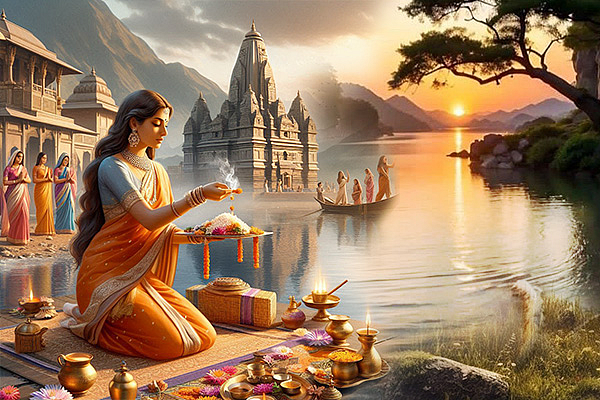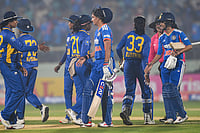Chhath Puja is one of the most devotional and disciplined festivals of Hindu tradition. For devotees, it is not just about rituals but about faith, gratitude, and purity. The festival is mainly celebrated in Bihar, Jharkhand, Uttar Pradesh, and the Tarai region of Nepal, but in recent years, it has spread across India and even abroad as people carry their traditions with them.
The four-day-long festival is dedicated to Lord Surya (the Sun God) and Chhathi Maiya, who is worshipped as the goddess of well-being and children’s health. Devotees observe strict fasting, pray near water bodies, and offer their thanks to the setting and rising sun.
Chhath Puja 2025: Date and Timings
Chhath Puja is celebrated six days after Diwali, during Kartik Shukla Shashti.
Chhath Puja Date - Tuesday, October 28, 2025
Sunrise on Chhath Puja Day - 06:02 AM
Sunset on Chhath Puja Day - 05:44 PM
Shashthi Tithi Begins - 06:04 AM on October 27, 2025
Shashthi Tithi Ends - 07:59 AM on October 28, 2025
Four Days of Chhath Puja 2025
Nahay Khay (October 25, 2025 – Saturday)
Devotees take a holy dip in rivers and start the ritual with pure vegetarian food cooked without onion and garlic.Kharna (October 26, 2025 – Sunday)
On this day, devotees observe a fast for the entire day, which is broken in the evening after preparing kheer, roti, and fruits.Sandhya Arghya (October 27, 2025 – Monday)
The main ritual of offering arghya (water offerings) to the setting sun takes place this evening at rivers or ghats. Families sing folk songs and prepare prasad like thekua.Usha Arghya (October 28, 2025 – Tuesday)
The last day of Chhath Puja, when devotees gather at dawn to offer prayers and arghya to the rising sun before breaking their fast.
Key Rituals and Prasad: The Heart of the Offerings
The offerings made during Chhath Puja are simple, pure, and deeply symbolic. They are typically carried to the ghats in a bamboo basket known as a soop.
Thekua: This is the most important prasad. It is a sweet, hard biscuit made from wheat flour, jaggery (or sugar), and ghee, and is often molded into beautiful designs.
Sugarcane: Full stalks of sugarcane are essential to the puja, symbolizing sweetness, prosperity, and a healthy harvest.
Bananas and Other Fruits: A bunch of green bananas is a mandatory offering. Other seasonal fruits like the pomelo (daabh nimbu) are also included.
The Arghya: This is the central ritual of offering water (mixed with milk and flowers) from a small pot (lota) to the sun, signifying gratitude and devotion.
History and Importance of Chhath Puja
Chhath Puja is considered one of the oldest surviving festivals in India, with its roots tracing back to the Vedic era. The rituals highlight the deep connection between humans and nature. Ancient hymns from the Rigveda praise the Sun God as the source of energy, life, and health, which reflects in the Chhath practices even today.
The worship of Surya and Chhathi Maiya symbolizes gratitude for sustaining life on Earth. Women, in particular, observe this puja with prayers for their family’s prosperity, children’s health, and overall well-being.
One of the most enduring legends connects Chhath Puja to the Mahabharata. It is believed that Karna, the son of Surya (the Sun God), was an ardent devotee who would stand in water for hours to offer his prayers. It is said that he distributed his wealth to the needy while performing these rituals. Similarly, Draupadi is also believed to have performed Chhath Puja to help the Pandavas regain their lost kingdom.
Significance of Chhath Puja
Purity and Discipline - The 36-hour-long nirjala vrat (fast without water) is one of the toughest in Hindu traditions, believed to purify the body and soul.
Ecological Connection - Rituals are performed by rivers and ponds, highlighting the importance of clean water and natural resources. Communities together clean ghats before the festival.
Social Harmony - Chhath Puja brings families, neighbours, and entire villages together. It is a festival where everyone participates, regardless of social or economic differences.
Symbol of Gratitude - Farmers especially see it as a way to thank the Sun for a good harvest, while families pray for prosperity and happiness.
Frequently Asked Questions (FAQ)
1. Who is Chhathi Maiya?
Chhathi Maiya is considered the sister of the Sun God, Surya. She is a Vedic goddess also known as Usha, the goddess of the dawn. Devotees pray to her to protect their children and grant longevity and health to their families.
2. Why is the setting sun worshipped during Chhath Puja?
Chhath is the only Hindu festival where the setting sun is worshipped. This ritual symbolizes the cycle of life, death, and rebirth. Offering prayers to the setting sun signifies gratitude for the day that has passed and acknowledges that darkness is a precursor to a new dawn.
Key Rules to Follow
Purity of Food and Kitchen
Only vegetarian and satvik food should be prepared with no meat, eggs, onion, or garlic.
The kitchen, stove, and utensils used for prasad must be thoroughly cleaned or new.
All food items, especially thekua and fruits, should be fresh and ideally prepared at home.
Fasting and Water Rules
The fast during Chhath Puja is one of the strictest, especially on the third day, when many devotees avoid even a sip of water.
The fast should not be broken before offering arghya at the correct time.
Devotees must maintain self-control and discipline throughout the ritual.
Cleanliness and Environment
Cleanliness is central to the festival. Devotees clean their homes, courtyards, and surroundings before the rituals begin.
The ghats (riverbanks) are also cleaned before the offerings, as they are considered sacred places for worship.
Mindset and Behavior
During Chhath Puja, devotees maintain a calm, respectful, and pure mindset.
Consumption of alcohol, tobacco, or any intoxicating substance is strictly prohibited.
The emphasis is on devotion, gratitude, and simplicity both in lifestyle and thought.
Why These Rules Matter
Every rule of Chhath Puja carries deep spiritual and environmental meaning.
The insistence on purity reflects the idea of cleansing both the body and soul.
Fasting symbolizes endurance, devotion, and surrender to divine energy.
Offering to the setting and rising sun represents harmony with nature and acknowledgment of its life-giving power.
Cleaning of ghats and collective participation strengthens social unity and reminds people of their bond with the community and the environment.
Practical Tips for Observing the Puja
Prepare all prasad items, fruits, and utensils a day before the puja begins.
Use natural items like bamboo baskets and earthen stoves wherever possible.
Follow the correct muhurat (timing) for offering arghya this varies slightly each year.
If you have health concerns, consult elders or priests before undertaking a full fast.
Family members who assist the devotee should also avoid tamasic food and maintain a clean environment.
Local Variations
Though the rituals are largely similar, there are slight regional variations. For instance, devotees in Bihar and Jharkhand may use different ingredients in thekua or prasad. In some areas, people decorate their courtyards with traditional designs or aripans.
While traditionally women were the main vrattis, today many men also observe the fast, showing how inclusive the tradition has become.
A Festival of Faith and Nature
Chhath Puja is more than just rituals, it is a reminder of how deeply human life is tied to nature. With its focus on the Sun, water, and earth, the festival encourages simplicity, self-discipline, and environmental respect.
As devotees gather on riverbanks and rooftops in 2025, the glow of lamps, the sound of folk songs, and the devotion in the air will once again make Chhath Puja a true celebration of faith, purity, and gratitude.























